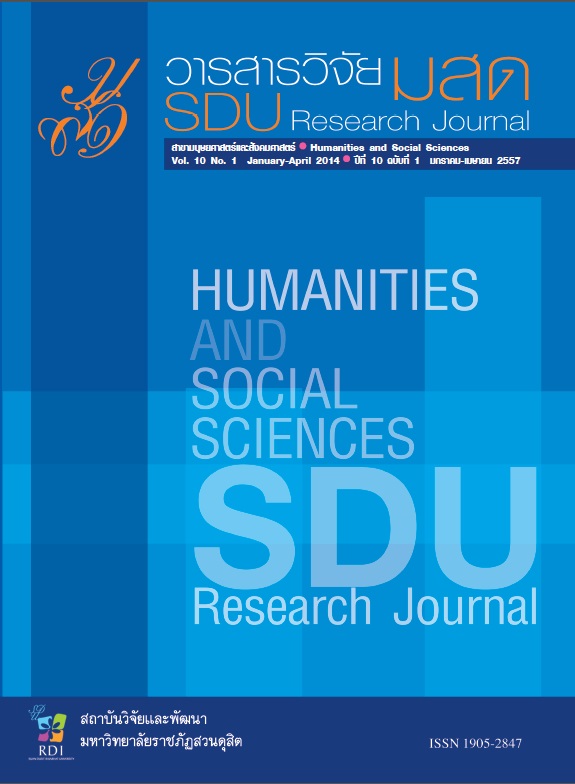การประเมินและติดตามผลการใช้สื่อ eDLRU ของโรงเรียนที่เป็นสมาชิกเครือข่ายของมหาวิทยาลัยราชภัฏสวนดุสิต
Keywords:
สื่ออิเล็กทรอนิกส์, วีดีโอ ออน ดีมานด์Abstract
บทคัดย่อ
การวิจัยครั้งนี้มีวัตถุประสงค์ดังนี้ เพื่อประเมินและติดตามผลการใช้สื่อ eDLRU และเปรียบเทียบผลการใช้สื่อ eDLRU จำแนกตามข้อมูลทั่วไปของครูที่สอนในระดับปฐมวัยและระดับประถมศึกษาสังกัดโรงเรียนที่เป็นสมาชิกเครือข่ายของมหาวิทยาลัยราชภัฏสวนดุสิต กลุ่มตัวอย่าง คือครูที่สอนในระดับปฐมวัยและระดับประถมศึกษา จำนวน 300 คน เครื่องมือที่ใช้ในการวิจัยเชิงปริมาณเป็นแบบประเมินการใช้สื่อ eDLRU สถิติที่ใช้ในการวิเคราะห์ข้อมูลคือ ค่าร้อยละ ค่าเฉลี่ยส่วนเบี่ยงเบนมาตรฐาน การทดสอบที การวิเคราะห์ความแปรปรวนทางเดียวและการเปรียบเทียบรายคู่ด้วยวิธีของเชฟเฟ การวิจัยเชิงคุณภาพใช้การสัมภาษณ์ ผู้ให้ข้อมูลสำคัญคือ ครูที่สอนในระดับปฐมวัย จำนวน20 คน และครูที่สอนในระดับประถมศึกษา จำนวน 20 คน วิเคราะห์ข้อมูลโดยการวิเคราะห์เนื้อหา ผลการวิจัยมีดังนี้
1. การประเมินการใช้สื่อ eDLRU ของครู โดยแบ่งออกเป็น 4 ด้าน คือ ด้านภาพรวมของสื่อ ด้านเนื้อหา ด้านประโยชน์ และด้านรูปแบบเว็บไซต์ พบว่า ในภาพรวมทั้งหมดครูส่วนใหญ่มีความคิดเห็นอยู่ในระดับเห็นด้วยมากที่สุด เมื่อวิเคราะห์รายด้านพบว่า ด้านประโยชน์เป็นอันดับแรกรองลงมาคือ ด้านรูปแบบเว็บไซต์ และอันดับสุดท้ายคือ ด้านเนื้อหา
2. การติดตามผลการใช้สื่อ eDLRU ของครูโดยแบ่ง เป็น 3 ด้าน คือ สภาพการใช้งาน ปัญหาและอุปสรรคในการใช้งาน และสิ่งที่ต้องการให้ช่วยเหลือ พบว่า 1) ด้านสภาพการใช้งาน ส่วนใหญ่เห็นว่าโครงการอบรมเชิงปฏิบัติการและสื่อ eDLRU มีประโยชน์ทำให้ได้รับความรู้เพิ่มขึ้นและนำสื่อไปใช้ประโยชน์ คือ นำไปใช้สลับกับการสอนปกติเพื่อเปลี่ยนบรรยากาศในการเรียน หรือเลือกใช้บางกิจกรรมที่ครูไม่มีความพร้อม และใช้เพื่อศึกษาเทคนิควิธีการสอน ครูได้นำสื่อมาประยุกต์ใช้และพัฒนาตนเองเพิ่มขึ้น 2) ด้านปัญหาและอุปสรรคในการใช้งาน เนื่องจากบางโรงเรียนระบบอินเทอร์เน็ตช้าบางโรงเรียนไม่มีระบบอินเทอร์เน็ตและไม่มีคอมพิวเตอร์ใช้ และ 3) สิ่งที่ต้องการให้ช่วยเหลือ คือ อยากให้ทำสื่อ eDLRU เป็นระบบ Offline โดยใช้กับเครื่องเล่น CD และสามารถดาวน์โหลดบทเรียนที่ต้องการได้
3. ผลการเปรียบเทียบการประเมินผลการใช้สื่อ eDLRU โดยจำแนกตามข้อมูลทั่วไปของครูพบว่า ครูที่มีอายุ ระดับการศึกษาสูงสุด หน่วยงานที่สังกัด และระดับชั้นที่สอนแตกต่างกัน มีความคิดเห็นในภาพรวมไม่แตกต่างกัน ส่วนครูที่มีประสบการณ์ในการทำงานแตกต่างกัน มีความคิดเห็น ในภาพรวมแตกต่างกันอย่างมีนัยสำคัญทางสถิติที่ระดับ .05
คำสำคัญ: สื่ออิเล็กทรอนิกส์ วีดีโอ ออน ดีมานด์
Abstract
The purposes of this study were: 1) to evaluate the implementation of eDLRU media by teachers in schools which were network members of Suan Dusit Rajabhat University and 2) to compare the results of eDLRU media implementation. The study employed mixed-methods in data collection. A set of questionnaires were distributed to 300 teachers in early childhood schools and primary schools that were network members of Suan Dusit Rajabhat University. A semi-structured interview collected qualitative data from 20 teachers in early childhood schools and 20 teachers in primary schools. Data analysis employed percentage, arithmetic mean, standard deviation, t-test, One-way ANOVA, and Sheffe′ method for multiple comparison testing. Content analysis was used to analyze qualitative data.
Three major findings revealed the following:
1) The results of eDLRU media evaluation indicated that most teachers were generally satisfied with the media at a high level. Regarding each aspect, the teachers rated the benefits of the media the highest, followed by the design and the content of the media.
2) Regarding the implementation of eDLRU in the three aspects of use, problems, and needed assistance, there were three notable results. Firstly, the media provided two advantages for teachers: 1) application of the eDLRU in regular teaching to change learning atmosphere and 2) application of the eDLRU as a guideline for self-study in applying and developing teaching techniques. Secondly, problems were slow Internet connection and lack of Internet and/or computers. Thirdly, the teachers needed help accessing media offline through CD players and gaining permission to download particular lessons.
3) Regarding teachers’ opinions towards eDLRU implementation, teachers who differed in age, educational level, working place, and teaching level were insignificantly different in their opinions, while the teachers who differed in working experience were significantly different in their opinions (p =.05)
Keywords: electronic media, VDO on demand








